


xxxxxThe city of Pompeii, near
to Naples, southern Italy, had been buried deep by the eruption of
Mount Vesuvius in 79 AD. As we have seen, its location was not
discovered until 1592 (L1),
and excavation of the site -
THE EXCAVATION OF POMPEII
and HERCULANEUM 1748 (G2)
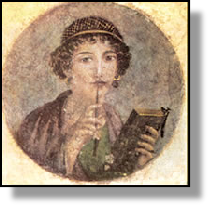
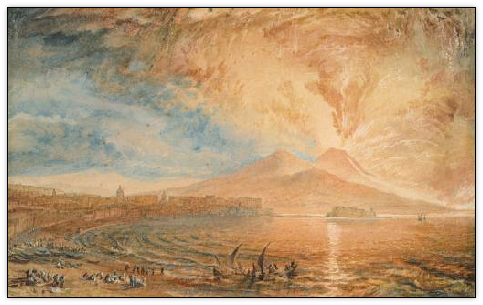 xxxxxBy the beginning of the Christian era, the city of
Pompeii, just 13 miles south of Naples in southern Italy, was a
thriving port with a population of some 20,000. In August 79 AD,
Vesuvius, the volcano which overlooks the city, suddenly erupted.
There followed a gigantic fall-
xxxxxBy the beginning of the Christian era, the city of
Pompeii, just 13 miles south of Naples in southern Italy, was a
thriving port with a population of some 20,000. In August 79 AD,
Vesuvius, the volcano which overlooks the city, suddenly erupted.
There followed a gigantic fall-
xxxxxSo deep was the city and
surrounding area buried beneath the debris, that the sites were
quickly abandoned. As we have seen, it was not, in fact, until 1592 (L1), that the Italian
architect Domenico Fontana, then the royal engineer at Naples,
stumbled upon some remains and awakened interest in the tragedy.
Even so, excavation with any serious intent did not begin until 1748, and fifteen years elapsed before an
inscription was found (reading rei publicae
Pompeianorum) to prove that the site was indeed that of the
ancient city of Pompeii. However, work at Herculaneum
had been started earlier. In 1709, while
sinking a well, part of the stage of the town's theatre was
discovered. Regular digging was begun in 1738, and a large amount of
art work was found, such as paintings and statues in bronze and
marble. In addition, in 1753 scrolls of papyri on various
philosophical subjects were recovered from a suburban villa -
Including:
Johann Winckelmann and
Giovanni Battista Piranesi

xxxxxWork
on clearing the site has been carried on intermittently ever since.
The removal of vast quantities of ash and cinder has proved a
formidable task, but, at the same time, the nature of the debris has
done much to preserve many of the city's public buildings and
private dwellings, as well as fossilising human and animal remains.
The baker’s shop, for example, had loaves on the shelves, and large
wine jars were found in the tavern. It is estimated that, so far,
three quarters of the ancient site has been uncovered. Systematic
excavations were begun in 1808 during the time of Napoleon but were
abandoned seven years later. Since 1860, when the Italian
archaeologist Giuseppe Fiorelli (1823-

xxxxxThese excavations provided a
remarkable insight into the life of a Roman city and town in the
first century AD. And the findings also had a marked effect on art
over the next thirty years or so. Jewellery, for example, took on
the simplicity and sense of harmony associated with the classical
age of ancient Greece and Rome. And this new neoclassical style was
seen in decorative motifs. The English pottery-
xxxxxThe German art historian Johann Winckelmann (1717-
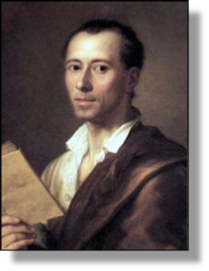 xxxxxIn the early years, the digging at Pompeii
and Herculaneum was spasmodic and in no way controlled. Many of those
working on the site were treasure seekers. In this respect the German
art historian Johann Winckelmann (1717-
xxxxxIn the early years, the digging at Pompeii
and Herculaneum was spasmodic and in no way controlled. Many of those
working on the site were treasure seekers. In this respect the German
art historian Johann Winckelmann (1717-
xxxxxWinckelmann was born in
Stendal, Prussia, the son of a cobbler. He was educated at the
universities of Halle and Jena, and began his working life as a
schoolmaster. However, in 1748 he became librarian to Count von
Bunau at Nothnitz, near Dresden, and it is here that he acquired an
interest in Greek art. This interest in antiquity took him to Rome,
where he eventually became the Vatican librarian and the
superintendent of the collection of antiquities held at the Vatican.
These positions enabled him to make a detailed study of ancient art.
and to play a major role not only in reawakening interest in the
"timeless" Greek ideal -
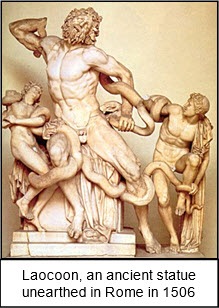
xxxxxHis major works were Reflections on the Painting
and Sculpture of the Greeks, written at Nothnitz and
published in 1755, and his History of the Art of
Antiquity, produced nine years later. These had a marked
impact not only on art -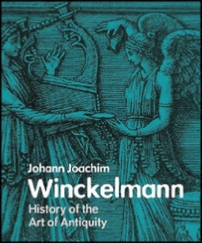 the
development of art history as an academic discipline in its own
right. In the History, for example, he
was the first to define the periods into which Greek art could be
divided, and some of his descriptions of individual pieces of art -
the
development of art history as an academic discipline in its own
right. In the History, for example, he
was the first to define the periods into which Greek art could be
divided, and some of his descriptions of individual pieces of art -
xxxxxStrange to relate, he never visited Greece, though he was invited by friends on a number of occasions. Thus the land and its art remained an ideal for him, and were probably made the more fascinating as a consequence. A mystery surrounds his death, but may be linked with his being a homosexual. He stopped at Trieste while returning to Rome from Venice, and was murdered by a chance male acquaintance. He was buried in the city, in the churchyard of the Cathedral of San Giusto.
xxxxxThe work of the Italian
engraver Giovanni Battista Piranesi (1720-
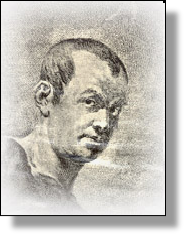 xxxxxAlso reawakening an interest in
classical antiquity during this period was the work of the Italian
engraver Giovanni Battista Piranesi (1720-
xxxxxAlso reawakening an interest in
classical antiquity during this period was the work of the Italian
engraver Giovanni Battista Piranesi (1720-
xxxxxMany of these technical masterpieces were contained in his two major series, Roman Antiquities of 1756, and his Views of Rome, published as single prints over a period of thirty years, beginning in 1748. These artistic, architectural works did much to influence the growth of neoclassicism in art and architecture, and, at the same time, to awaken an interest in archaeology, especially in France and England. (The print below, left, shows the remains of the Temples of Jupiter and Fortune.) A number of prominent architects visited him in his print shop in Rome, including the English designer Robert Adam, to whom Piranesi dedicated an engraving and a book.

Acknowledgements
Roman Painting: date and artist
unknown – Museo Archeological Nazionale, Naples. Vesuvius: watercolour by the English painter Joseph Mallord
William Turner (1775-
G2-
xxxxxToday, this brilliant engraver is best remembered for an earlier series of etchings entitled Carceri d'invenzione (Imaginary Prison Scenes), begun in 1745. These are remarkable for their flights of fancy and romantic imagination, featuring as they do a tangled mass of gloomy dungeons, eerie vaults, lofty ladders, and swirls of stairs and galleries that lead to nowhere (illustrated above on right.). Thus whilst his prints of ancient Rome played a part in the growth of neoclassicism, these bizarre works had a decided influence on 19th century romanticism and, indeed, upon the surrealist movement of the following century.
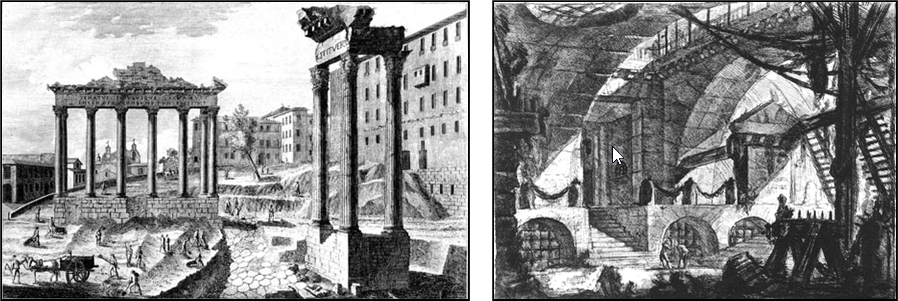
xxxxxIn all, he produced some 3000 etchings but, as an architect, he also found time to carry out some restoration work for pope Clement XIII, and the romantic Piazza dei Cavalieri di Malta was constructed to his design.



